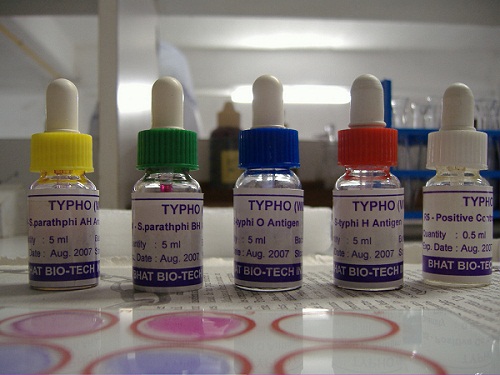


Typhoid fever is a life threatening condition that attacks over 21 million people around the world each year. Also known as enteric fever, typhoid is rare in the United States and other developed countries but is still an ongoing threat to those who live or visit developing nations. Caused by the bacterium Salmonella Typhi, typhoid is often transmitted by the ingestion of food or drinks that have been contaminated by fecal matter. In areas such as the US, automated modern tests using state-of-the-art equipment are available, but in underdeveloped nations where resources are slim, a testing process more than 100 years old, the Widal test, is often used to confirm the diagnosis of typhoid fever.
 The only place where the bacterium Salmonella Typhi lives is in the intestinal tract and bloodstream of humans. Some people continue to store the bacterium in their gall bladders even after they have recovered from the illness. They are called carriers, and both carriers and current sufferers of typhoid shed that bacterium in their stools. If food or drink is contaminated by the bacterium, anyone consuming it can be at risk to develop typhoid fever.
The only place where the bacterium Salmonella Typhi lives is in the intestinal tract and bloodstream of humans. Some people continue to store the bacterium in their gall bladders even after they have recovered from the illness. They are called carriers, and both carriers and current sufferers of typhoid shed that bacterium in their stools. If food or drink is contaminated by the bacterium, anyone consuming it can be at risk to develop typhoid fever.
If you live or travel in regions such as Africa, India, Asia, or Latin America, you could be exposed to this illness. Symptoms of typhoid may include high fever, weakness, abdominal pains, headaches, decrease in appetite, or development of a rose-colored rash consisting of flat spots. If you have these symptoms, you may have contracted typhoid.
There are a variety of tests that may be used to diagnose typhoid fever. Those include a complete blood count (CBC) to look for an overabundance of white blood cells, a blood culture to reveal if there is Salmonella Typhi in the bloodstream, or an ELISA urine test which also helps identify the presence of the bacterium. Other tests may include a stool culture, a platelet count, or a fluorescent antibody study.
All of these tests do require the use of expensive, technically advanced equipment. In many countries where typhoid is still an imminent threat, the equipment or trained personnel to use it is simply not available readily. That is why the Widal test is still commonly used in those regions. It is simpler, faster, and easier to perform when modern laboratories are not a possibility.
The Widal test is an agglutination test employed in the serological diagnosis of enteric fever, aka typhoid. Agglutinins are antibodies that direct red blood cells to gather together, forming clots that are visible to the naked eye.
George Ferdinand Widal developed and introduced the test in 1896. It involves the use of a test tube or slide and a blood sample from the person suspected of having typhoid. The test relies on seeing a reaction between antibodies present in the ill person's blood and exact antigens of S. typhi. Unfortunately, this method is slow and may take 7-14 days to confirm the diagnosis. Other problems with the Widal test include the fact that it cannot distinguish between someone who currently has typhoid, someone who is a carrier, and someone who has been vaccinated against the illness. It can also give false positives and may actually mistake typhoid for similar illnesses such as malaria.
The Widal test requires no special preparation. If you have ever had a blood test conducted, you already know what to expect. When you arrive at the lab, you’ll be seated and a rubber tourniquet will be placed around your upper arm. The spot where the blood will be drawn from (usually the elbow or upper hand) will be wiped with antiseptic and a thin needle inserted into the vein to collect the blood sample. The sample is then set to the laboratory to be analyzed.
The pain involved is no worse than that of any other blood test. Some people feel weak or faint during the test and a small bruise may develop at the site. Other than that, there are few reactions to the Widal test.
 The goal of the Widal test is to determine the “O” and “H” agglutinin titer levels in the patient’s blood. The test is considered negative when the O and H agglutinin titer level is below 1:160. If those levels are above that number, then typhoid is a definite possibility. Because of the inconsistency of the test, however, it is often suggested that a second Widal test be conducted within a week or so following the first one.
The goal of the Widal test is to determine the “O” and “H” agglutinin titer levels in the patient’s blood. The test is considered negative when the O and H agglutinin titer level is below 1:160. If those levels are above that number, then typhoid is a definite possibility. Because of the inconsistency of the test, however, it is often suggested that a second Widal test be conducted within a week or so following the first one.
Note: Typhoid is still endemic in many countries throughout the world and global travelers may bring the illness home to their own country, friends, and family. If you have been traveling to underdeveloped parts of the world and are showing symptoms of typhoid fever, seek immediate medical help and get a Widal test or other diagnostic procedures to confirm your diagnosis. This illness can be successfully treated with antibiotics; but if left untreated, serious damage or even death can result.